Can you imagine hiking on a trail, turning a corner, and seeing a huge King cobra with its head raised to your eye level, puffing, and hissing, bobbing its head back and forth with half-inch fangs ready to strike? Now that would be scary!
King cobras are the largest venomous snake in the world, with some that can get to 18 feet long. What about a snake that spits venom or gnaws on its victim?
Are there snakes that strike over and over again? Let’s find out about some of the scariest snakes in the world.
10. What Is the Biggest Scary Snake in the World?
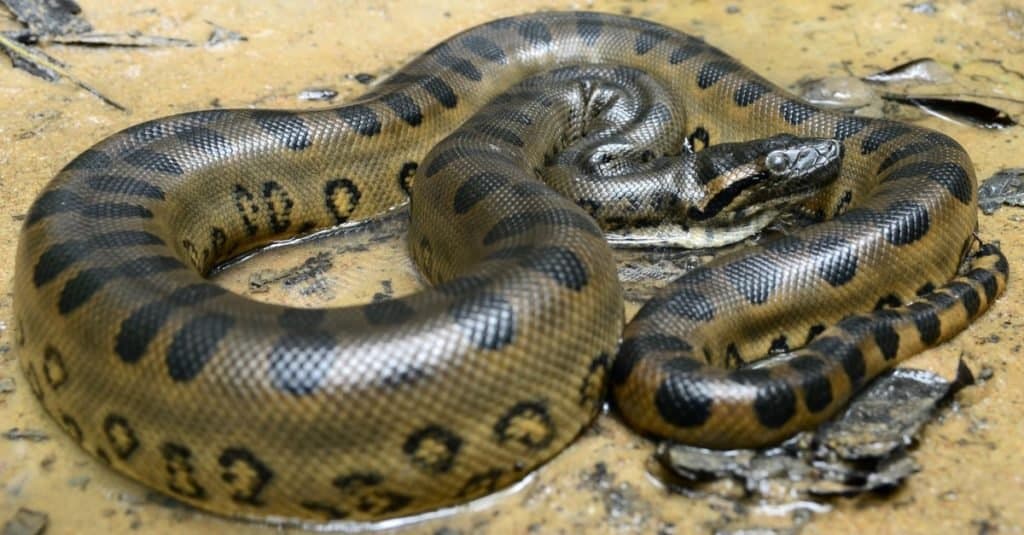
The Green Anaconda can be 20-30 feet long and weigh 550 lbs.
©Patrick K. Campbell/Shutterstock.com
The Green Anaconda is the biggest snake in the world. It lives in the rainforests in South America. A green anaconda can grow to be over 20 feet long. If an office cubicle is 10 feet long, this snake will reach 3 office cubicles long. And we are not talking about a snake the size of a garden hose; this snake is thick! While it’s unverified, the largest ones were estimated to weigh as much as 550 lbs! Definitely one of the scariest snakes!
9. What Snake Has the Scary Combination of Red, Yellow, and Black?

Coral snakes have a distinct black, yellow, and red coloration.
©iStock.com/JasonOndreicka
Another one of the scariest snakes is the coral snake. You may have heard the catchy life-saving rhyme, “Red touching black, safe for Jack. Red touching yellow, kill a fellow.” I prefer the rhyme, “Red, yellow and black, just stay back!” Why take the chance?
However, the rhyme isn’t always accurate, and relying upon it is not safe – it only helps confirm a typical North American coral snake. There are North American coral snakes with aberrant patterns that don’t fit the rhyme — and don’t even bother using it outside of North America.
The eastern coral snake lives in the southeastern states of the United States. Coral snakes are skinny snakes that get to be about 3 feet long. They are banded with alternating wide black, thin yellow, wide red, thin yellow, and wide black designs. They have small heads but deliver a potent venom, a neurotoxin that affects the nervous system. Seek immediate medical attention if you are bitten by any red, yellow, or black snake, to be safe.
8. What Snake Has Horns?

Horned vipers have horns above their eyes, and they are venomous.
©iStock.com/Mark Kostich
Horned vipers are snakes that have modified scales that form horns above their eyes. They are venomous and live in the Middle East and African deserts. They hide in the sand and wait to ambush their prey, but humans are not one of their targets. These vipers are smaller snakes, usually less than 2 feet long, and prefer lizards and rodents as prey.
7. What Snake Has the Scariest Fangs?
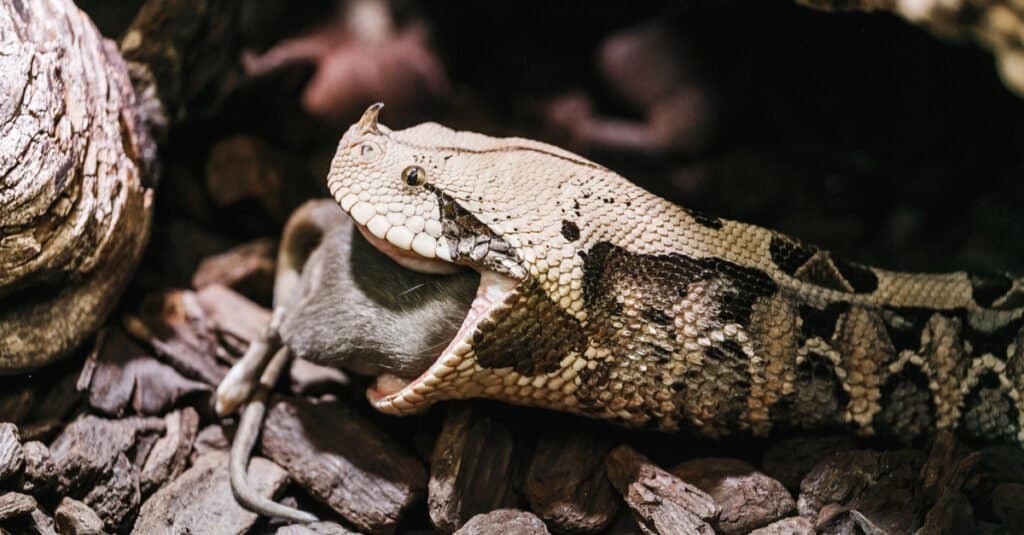
Gaboon Vipers have the longest fangs in the world. Some can reach 2 inches long and deliver a painful bite.
©frantic00/Shutterstock.com
Gaboon Vipers have the scariest fangs! They have the longest fangs in the world, with some measuring nearly 2 inches long! These snakes don’t just bite-n-go; they hang on to dispense the most possible venom. The Gaboon viper bite is one of the most painful snake bites in the world. Luckily, they are not aggressive snakes, so bites are not common.
6. What Scary Snake Bites More Than Once?
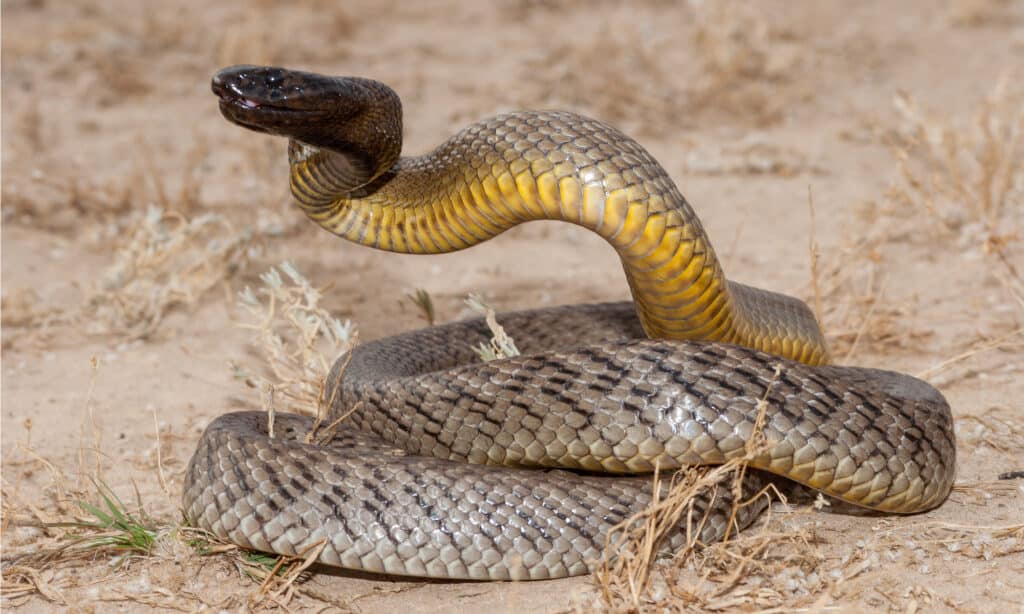
The Inland Taipan has one of the most lethal venoms in the world.
©Ken Griffiths/Shutterstock.com
The Inland taipan, also called the fierce snake, is very scary because not only does it have one of the most lethal venoms in the world, it bites more than once. According to research, one bite is deadly enough to kill 100 men, but it bites, reloads, and bites again, over and over! If you get bitten, you may only have 30-45 minutes before the neurotoxins present in its venom cause paralysis and death.
The good news is that it lives in remote parts of Australia and rarely comes in contact with humans.
5. What Scary Snake Hisses and Spits Venom?
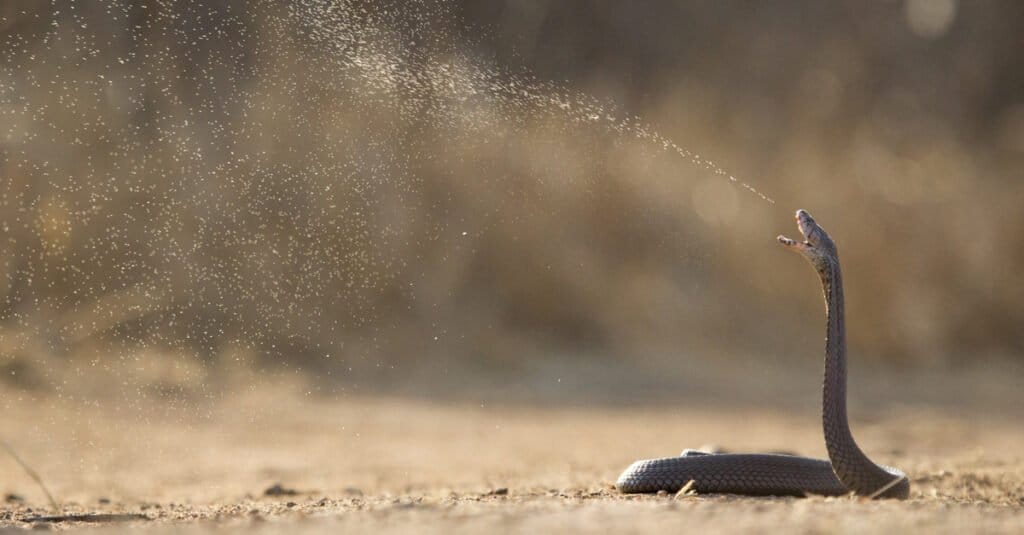
The Mozambique-spitting cobra can spit its venom up to 10 feet.
©Stu Porter/Shutterstock.com
The Mozambique spitting cobra is a highly venomous snake that can raise its body, make threatening hisses, and spit venom up to 10 feet away! The venom is cytotoxic, causing tissue damage where it comes into contact with your skin. If it sprays venom in your eyes, you could go blind.
This cobra can be found in countries in southern Africa, including Mozambique. According to a research study of Mozambique spitting cobras, “A large percentage of the bites (94%) occurred inside human dwellings, and of these, 81% occurred while the victims were asleep.” Now that is scary!
4. What Snake Wraps Itself Around Its Victim Crushing It to Death?
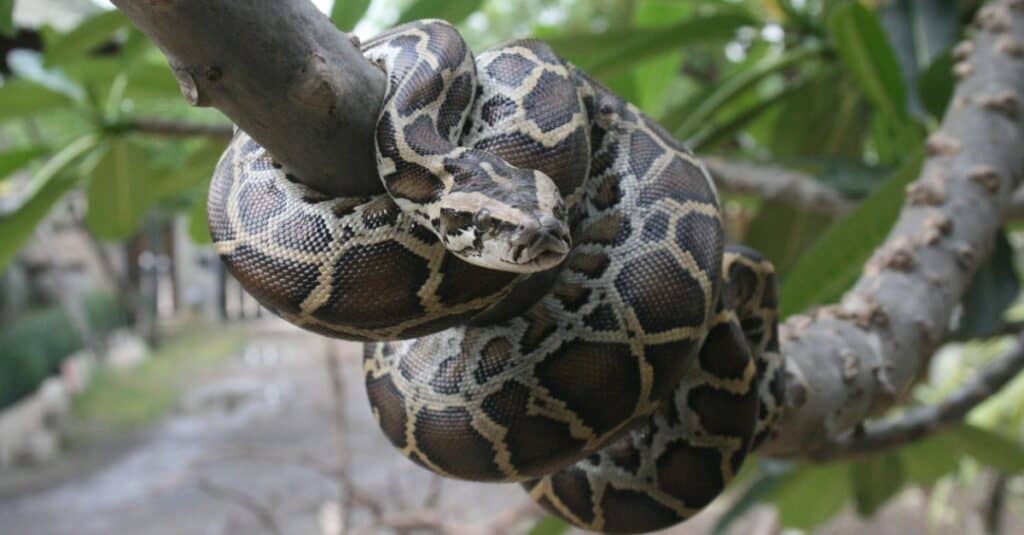
Pythons wrap around their prey and squeeze until its heart stops before swallowing it whole.
©iStock.com/Lunatic_67
If you fell to the ground and came face to face with a Reticulated Python, you could be in for the “hug of your life.” These giant snakes wrap themselves around their prey and squeeze until it stops breathing. For many years, people believed it was because they were asphyxiated. However, newer research indicates that it’s more likely that the pressure from this super-hug causes cardiac arrest.
Regardless of how they kill, snakes swallow their prey whole. In 2018, several news outlets, including USA Today, the Washington Post, and the BBC, reported that an Indonesian woman was attacked and swallowed whole by a 23-foot Reticulated Python! The villagers found a large, bloated snake nearby and cut it open to recover the dead woman’s body. Now, that is scary.
3. What Scary Snake Gnaws Viciously on Its Victims?

Boomslangs can gnaw at their victim and deliver a deadly venom.
©iStock.com/FroeMic
Don’t be fooled by the cute green, big-eyed, Boomslang. It looks like a garden hose with cartoon eyes. You find it attractive until the mouth is opened at 170 degrees, revealing two large fangs in the back of its jaw. Boomslangs are rear-fanged snakes in the Colubridae family. Their fangs’ location means that they need to get their mouths opened pretty wide to deliver their deadly venom.
Their venom is slow-acting but can be fatal because of the damage it does to blood clotting. There is an anti-venom to cure the effects of the bite. Fortunately, bites from these snakes are rare because boomslangs tend to flee the moment they sense a bigger animal nearby. They can be found in Sub-Saharan Africa in South Africa, Swaziland, Namibia, Zimbabwe, and Mozambique.
2. What Is the Deadliest Snake in the United States?

The Mojave
rattlesnake
is the most deadly snake in the United States.
©Creeping Things/Shutterstock.com
The Mojave rattlesnake has some of the most dangerous venoms of all rattlesnakes in the United States. It is found in the southwestern states of Arizona, Texas, New Mexico, California, and Nevada. Rattlesnakes, while frightening, typically try to warn you away from them by rattling.
When that fails, they escalate the warning level by coiling up in preparation for a strike. Their venom contains neurotoxins and hemotoxins, which can attack your nervous system and slow blood clotting. In the United States, most medical facilities have anti-venom, which can treat the effects of the bite.
1. What Is the Deadliest Snake in the World?
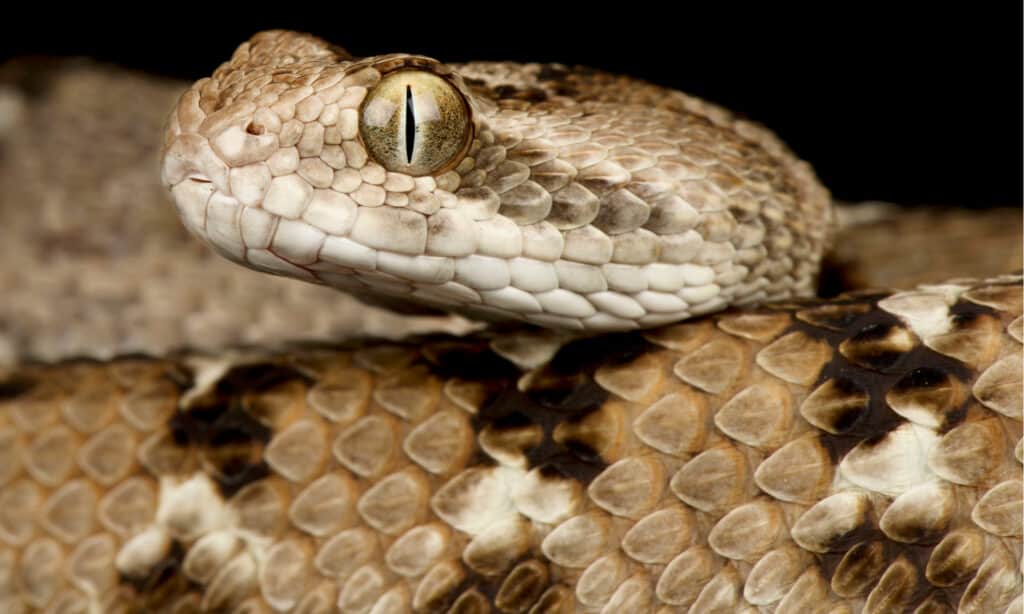
The Saw-scaled viper is the deadliest snake in the world.
©reptiles4all/Shutterstock.com
The Saw-scaled viper is the deadliest snake in the world. It is not the largest snake, about 3 feet long, but it kills more people than any other snake. This snake is found in West Africa and parts of South Asia, including India. The nocturnal saw-scaled viper is quick to bite when it gets scared. It rubs coils of its body together to make a hissing sound as it moves.
The venom of the saw-scaled viper wreaks all kinds of havoc. Some snake venoms just paralyze the victim, but the saw-scaled venom has cardiotoxins (attacks your heart), neurotoxins (attacks your nervous system), and hemotoxins (makes it hard for your blood to clot so you bleed internally). These bites can be fatal in areas with no local access to health care. In my book, deadly=scary, so the saw-scaled viper is the scariest snake in the world!
Other Scary Reptiles
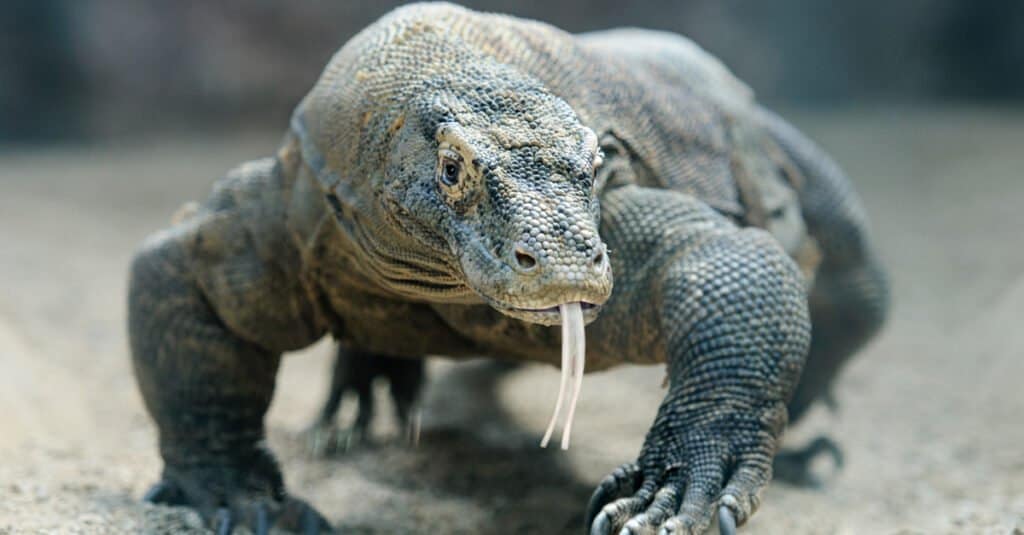
The Komodo dragon is one of the more dangerous animals you may encounter.
©Anna Kucherova/Shutterstock.com
The diverse group of creatures known as reptiles are distinguished by its special adaptations and occasionally menacing look.
When people think of frightening reptiles, snakes may be the first thing that comes to mind, but there are many more reptiles that have the power to make people afraid. The world of reptiles is full of animals that can make you tremble, from huge lizards to poisonous turtles.
Here is a list of some of the more common scary reptiles that are not snakes:
- American Alligator
- American Crocodile
- Komodo Dragon
- Gila Monster
- Green Iguana
- Nile Monitor
- Saltwater Crocodile
- Black Caiman
- Bearded Dragon
- Frilled Lizard.
The photo featured at the top of this post is © Joe McDonald/Shutterstock.com
Discover the "Monster" Snake 5X Bigger than an Anaconda
Every day A-Z Animals sends out some of the most incredible facts in the world from our free newsletter. Want to discover the 10 most beautiful snakes in the world, a "snake island" where you're never more than 3 feet from danger, or a "monster" snake 5X larger than an anaconda? Then sign up right now and you'll start receiving our daily newsletter absolutely free.
Thank you for reading! Have some feedback for us? Contact the AZ Animals editorial team.






